ART |
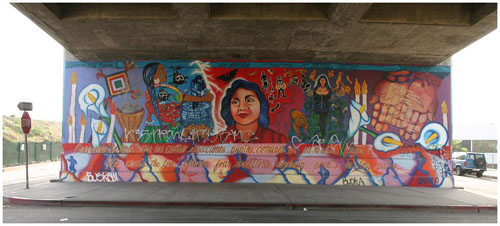
(Photo by © Robin Dunitz)
La Ofrenda
"La Ofrenda" is a 36' x 20' mural which was painted on Toluca St. under the 1st St. bridge in Los Angeles, CA in 1990. Yreina was assisted by Claudia Escobedes, Erick Montenegro, Vladimir Morales, and Sonia Ramos. This mural is a tribute to the struggle that was endured by the farmworkers and during the Chicano movement. Cervantez emphasizes the role of women by focusing on Dolores Huerta, a longtime leader of the United Farmworkers Union. This image symbolizes all the work that was done by Chicana activists during the Chicano movement which was often downplayed and overshadowed by the importance claimed by men in the movement. Women worked extremely hard in daily activities, doing most of the grassroots organizing. Men did most of the strategizing sessions, away from women, which did not involve the actual Chicano community.This is showcased in the mural because she goes against the cultural tyranny and against the idea that women were supposed to stay at home and let the men do the work. Even though many times the men were the ones with the leader positions, in this mural Cervantez chose to put Huerta as the leader.
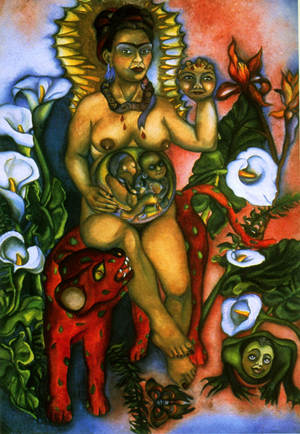
(Photo Provided by Laura Perez's Chicana Art)
Homenaje a Frida Kahlo
"Homenaje a Frida Kahlo" is a 20 x 14 inch watercolor painted in 1978. This painting is one of Cervantez's earliest self-portraits in which she looks at her own image through a small mirror held up by Frida Kahlo. Cervantez honors herself by viewing her image as Kahlo's double. "In picturing herself as the brilliant Kahlo's double, she symbolically cross-dresses a third time time in this homage of the artist as Christian, pre-Columbian, and art world goddesses all at once. No wonder Cervantez pictures herself smiling impishly, while her patroness looks on pointedly" (Perez, 281).
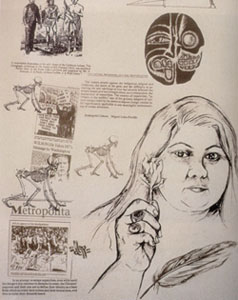 |
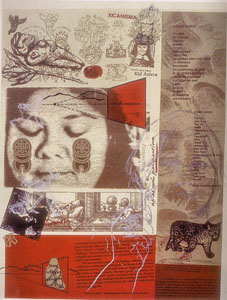 |
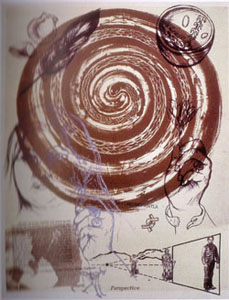 |
(Photos Provided by Laura Perez's Chicana Art)
Nepantla
"Nepantla" is a 22 x 17 inch lithograph triptych painted in 1995. These paintings consist of three panels: Nepantla, Mi Nepantla, and Beyond Nepantla. Through these images, she aims to "undermine racist and sexist histories of representation that inform the fields of visual art in which she works" (Perez, 37). Her first panel introduces "nepantlism" as an ongoing struggle between two cultural identities. She uses the image of skeletal figures as the representation of how cultures have evolved and developed through time. her panels demonstrate the conflicts she has experienced being a Chicana artist. The second panel is more of a self-portrait, in which Cervantez identifies with Coyolxauqui, the warrior daughter of Coatlicue. The panel documents gendered and racial cultural losses, which she has experienced herself. The most prominent image in the third panel is the dark spiral of the feathered serpent, the glyph of Quetzalcoatl. Cervantez uses a lot of images that represent Indian culture. Finally, Perez explains, "Cervantez's triptych operates as an offering, hybridizing or broadening dominant cultural and visual politics under the glyph of balanced dualities and change" (Perez, 45).